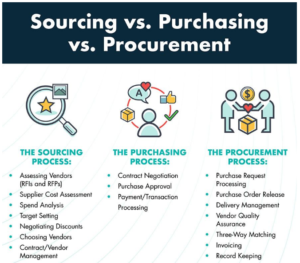
In the field of Supply Chain Management, there are concepts that seem very familiar but not everyone fully understands their nuances. For example, there are three terms related to the procurement department: Purchasing, Sourcing, and Procurement. These three concepts are often used interchangeably and understood as buying goods for the business. However, the truth is that all three aim towards the ultimate goal of purchasing, but they differ in meaning and operation. Understanding these three terms correctly helps to define one’s job scope most effectively.
Fundamentally, Purchasing is an indispensable activity for a manufacturing business in particular, and within the scope of a supply chain in general. Some businesses establish Purchasing Departments to directly carry out the tasks, while others use outsourced services. Regardless of the approach, to ensure the efficient flow of goods, information, and finances, businesses are required to have a department responsible for the Purchasing function.
Procurement: The overall process of planning, straitening purchasing, and maintaining procurement activities is collectively referred to as Procurement. The objects of Procurement activities can be raw materials or services needed for the manufacturing process, equipment serving the production process, or goods or services necessary to sustain company operations. The Procurement process also encompasses activities such as:
- Planning purchases (Planning)
- Sourcing suppliers (Sourcing)
- Selecting suppliers (Supplier Selection)
- Negotiating prices and terms (Negotiation)
- Contract signing and handover (Transaction and Contract management)
- Measuring supplier effectiveness (Supplier Performance Management)
- Maintaining supply stability (Supplier Sustainability Issues).
Sourcing: Speaking of Sourcing refers to the initial stages in the Procurement chain. Sourcing involves input activities including searching for and evaluating suppliers’ effectiveness to move towards an agreement. Sourcing activities focus on how to select the right source with criteria set by the company such as cost, quantity, quality, time, location, and the strategic nature of long-term cooperation with suppliers.
Searching for suppliers is highly strategic, and those involved in Sourcing are always in a position to balance costs and product quality as well as the company’s benefits. The less spent on raw materials, the better the profit margin for the business. Cost savings are important, but if only price is considered, product quality can easily be overlooked.
Purchasing: As a “subset” of Procurement, the term Purchasing is often used with a narrower connotation. Purchasing simply involves the straightforward activity of buying a particular type of goods and services, receiving them, and making payments—thus, Purchasing is primarily limited to transactional functions. Efficient Purchasing activities ensure low costs, fast supply times, and improved supply chain quality. A typical purchasing process includes:
- Receiving purchase requests
- Creating and distributing purchase orders
- Receiving products/services
- Ensuring the quality of received products/services
- Arranging payment for the supplier.

In summary, Procurement is the broadest and most comprehensive concept, encompassing both Purchasing and Sourcing, and all are important activities within a company’s supply chain. However, depending on the scale and nature of each business or industry, Purchasing, Sourcing, and Procurement may not be distinctly separate; they are often grouped together and understood as purchasing activities. We hope that mastering the meanings and usage scope of these terms will facilitate your work.
